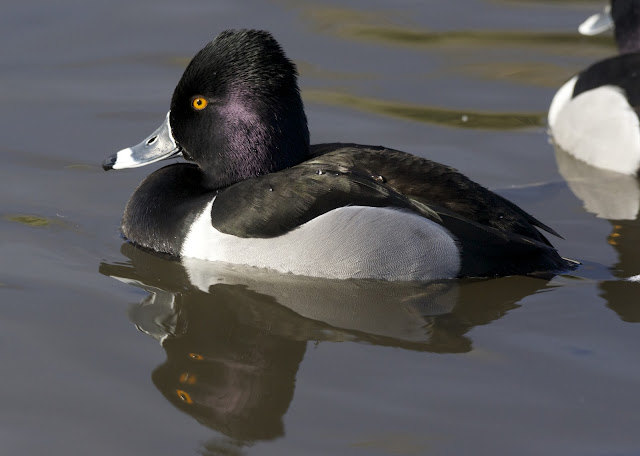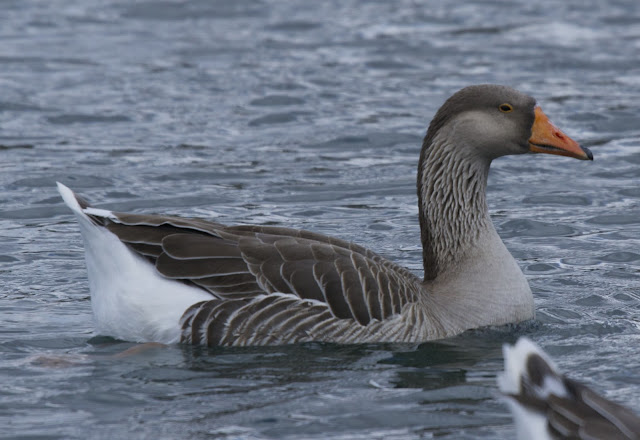As mentioned in a previous post, I spent last Saturday morning at Tres Rios with Pops chasing after a vagrant Northern Parula and Chestnut-sided Warbler. Of course, we also had an eye out for the other birds around Tres Rios--and there are always plenty--but having dipped on the vagrant warblers and not come away with much in way of photos, it was a somewhat disappointing trip. It felt like the morning had been wasted a bit. So after leaving Tres Rios and indulging in some fortifying lunch, I traded this western extremity of the Phoenix area for far east Mesa, exploring some sites along the Salt River where a Red-breasted Sapsucker has been residing since December.
Since our vagrant warbler quarry at Tres Rios was supposed to be in a single large clump of eucalytpus, we spent most of our time there around those few tress, and as such our species diversity was low.
There were plenty of Lincoln's Sparrows hanging out in the brush piles around the big trees, and some bedraggled Abert's Towhees filled the brisk morning air with their shrieking.
Seeing this Abert's Towhee, and hearing them singing/calling so much, reminded me of how few Thrashers I see at Tres Rios. There could potentially be Bendire's, Sage, and Curve-billed, even Crissal, but I do not believe I have ever seen a Thrasher there. What a dreadful dearth!
Tres Rios does have lots of Cinnamon Teal in the spillways right now, so at least there's that.

We did see lots of raptors during our eucalyptus steak out, with Harris's Hawk, Red-tailed, Cooper's, Sharp-shinned, Osprey, Kestrels, and a Bald Eagle all making for a very carnivorous morning. We didn't pick up Peregrines or Ferruginous Hawks, nor the single Red-shouldered in the area, so factoring these in too, Tres Rios can really bring in the big birds.

Eventually our focus and interest waned at Tres Rios, plus pops had some cool, important mechanic-type stuff to do back at home. Feeling a bit defeated, especially with this being my only birding thus far in the the week and weekend, I decided to head over to the Pebble Beach site, about eight miles east from the Salt River dam, to investigate a lost and stubborn woodpecker.

This reclusive, yet very chromatically conspicuous Red-breasted Sapsucker was first found during a December CBC (Christmas Bird Count) in the area, and it's been seen off and on since then. The Pebble Beach site is much like any of the other picnic/hiking areas along the Salt River--some concrete tables, dusty trails, and scattered clumps of chaparral. Honestly, it's not my favorite habitat in which to go birding, but hey if beautiful birds like it, I can like it too.
I arrived at the Pebble Beach site around 3pm--not an ideal birding time--and first just sort of wandered around, curious to see what would turn up. The first half hour produced lots of Phainopeplas and Gila Woodpeckers, but no Sapsuckers. I eventually noticed some mesquite trees with lots of fresh-looking sap wells in them, and figured that maybe with some patience (the worst!) somebody would visit.

Frustratingly enough, the first birds to come by the sap wells during my vigil were Yellow-rumped Warblers and House Finches. Assumedly they weren't eating the sap, as Sapsuckers sometimes do, but were just enjoying some of the insects the sweet sticky stuff attracts (which Sapsuckers also do). But after another ten minutes I saw a flash of black, white, and red entering my peripheral vision.
What a stunner! I saw one of these birds several years ago in Northern California, but the sighting was brief and distant. Seeing it again, fairly close, and against such a comparatively dull and dreary background...it rocked my socks off.
After ogling this splendid specimen for a little while and watching him move on to other wells, I located and re-applied my socks, before heading back to the car and west towards the Granite Reef Dam. The Granite Reef site is the western most site along the Salt River, and is also, overall, the birdiest. The guest parking area hosts lots of different Sparrows and Flycatchers while the adjacent river walk gives one the opportunity to view lots of waterfowl, including Mergansers and Goldeneye.
While observing this slinking female Ladder-backed Woodpecker, I ran into fellow Arizona birder, blogger, and photographer
Gordon Karre, who was showing the sites to another birder from New Jersey. It's always nice to run into other birders and bloggers. Earlier that day I had bumped into Jeff Ritz and some of his crew out at Tres Rios, and I met another very knowledgable birding couple while looking at the Sapsucker.
There wasn't actually a lot going on at the Granite Reef site, though the fellow from New Jersey, having apparently not birded Arizona or much of the southwest before, was racking up lifers like crazy, including the Ladder-backed Woodpecker pictured above.
So I found some good birds and good birders. Tres Rios let me down a bit, but I saw a gorgeous Sapsucker so the day didn't...err hem...'suck' after all.
Plus, I went back and got the Parula on Monday, so Tres Rios and I can still be friends too.



























































